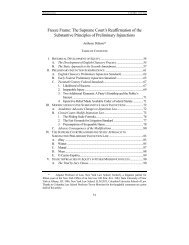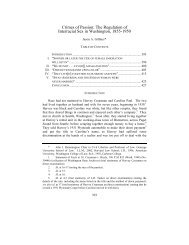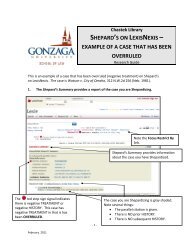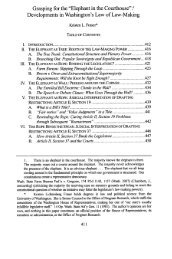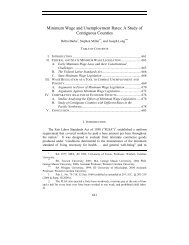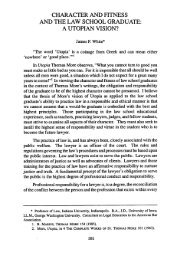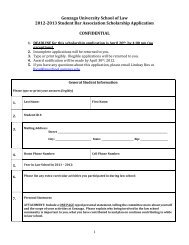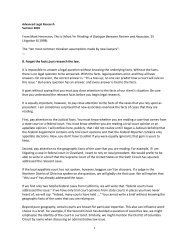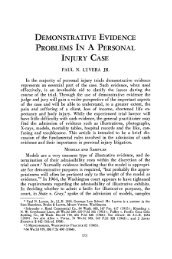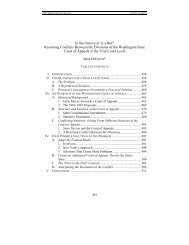professional responsibility, student practice, and the clinical
professional responsibility, student practice, and the clinical
professional responsibility, student practice, and the clinical
You also want an ePaper? Increase the reach of your titles
YUMPU automatically turns print PDFs into web optimized ePapers that Google loves.
GONZAGA LAW REVIEW<br />
[Vol. 26:2<br />
<strong>the</strong> way people learn. 9 But unless <strong>the</strong> criticism is palpable to <strong>the</strong> client, it is<br />
not intervention in <strong>the</strong> sense that <strong>the</strong> clinic teacher has directly assumed<br />
<strong>responsibility</strong> for performing <strong>the</strong> lawyering activity in question."°<br />
I use <strong>the</strong> term "<strong>clinical</strong> teacher" to denote one who has obligations of a<br />
<strong>professional</strong> nature to <strong>the</strong> client but, unlike <strong>the</strong> supervising attorney operating<br />
9. For a discussion of cooperative versus competitive <strong>and</strong> coercive teaching in <strong>the</strong> law<br />
clinic, see Condlin, Socrates' New Clo<strong>the</strong>s, supra note 6. Condlin stresses <strong>the</strong> value of<br />
interacting <strong>and</strong> communicating in a "learning" ra<strong>the</strong>r than a "persuasive" mode in order to<br />
avoid teacher domination <strong>and</strong> manipulation of <strong>the</strong> <strong>student</strong>. The learning mode is<br />
characterized by <strong>the</strong> identification, disclosure, <strong>and</strong> non-coercive discussion of value<br />
preferences implicit in teaching; <strong>the</strong> persuasive mode is "hide <strong>the</strong> ball" teaching whose<br />
objective is to convince o<strong>the</strong>rs while minimally disclosing one's values, motive or purpose<br />
<strong>and</strong> without considering <strong>the</strong> o<strong>the</strong>r's ideas or views. Condlin argues that too much <strong>clinical</strong><br />
teaching is of <strong>the</strong> persuasive mode variety <strong>and</strong> <strong>the</strong>refore not distinguishable from <strong>the</strong> more<br />
manipulative (Socratic) classroom techniques <strong>clinical</strong> teachers profess to avoid. But see<br />
Spiegelman, supra note 1, at 246-47 ("[E]xcept in clinics <strong>and</strong> <strong>practice</strong>-skills courses, in<br />
teaching about alternative dispute resolution, <strong>and</strong> in humanistic approaches to legal<br />
education, cooperation is largely neglected .... " See R. JACK & D.C. JACK, supra note<br />
3 (for a general discussion of <strong>the</strong> failure of traditional law school teaching methods to help<br />
<strong>student</strong>s confront <strong>and</strong> bridge <strong>the</strong> gap between <strong>professional</strong> ethics <strong>and</strong> personal morality).<br />
The authors argue that law schools model what <strong>the</strong>y teach on, an adversarial system, <strong>and</strong><br />
that traditional combative teaching techniques must be modified or supplemented with more<br />
cooperative, less alienating forms of instruction. Id. at 44-47, 166-67.<br />
10. Professor Condlin defines <strong>clinical</strong> <strong>practice</strong> instruction as "strategic intervention<br />
by law teachers in <strong>student</strong> performance of lawyering tasks." Condlin, Socrates' New<br />
Clo<strong>the</strong>s, supra note 6, at 223. He defines intervention more broadly than I by reference to<br />
<strong>the</strong> following concept: "[In intervening] ... a [teacher] ... assists a [<strong>student</strong>] to become<br />
more effective in problem-solving, decision-making <strong>and</strong> decision implementation in such a<br />
way that <strong>the</strong> [<strong>student</strong>] can continue to be increasingly effective in <strong>the</strong>se activities <strong>and</strong> have<br />
a decreasing need for <strong>the</strong> [teacher] .... " See Condlin, id. at 223 n.1 (quoting C. ARGYRIS,<br />
INTERVENTION THEORY AND METHOD: A BEHAVIORAL SCIENCE VIEW 15-16 (1970)).<br />
Condlin believes it is preferable to intervene non-coercively. See supra note 9. However,<br />
he acknowledges that <strong>the</strong>re are ethics-driven instances in <strong>clinical</strong> education when coercive<br />
behavior on <strong>the</strong> part of <strong>the</strong> teacher would be appropriate: "For example, if a <strong>student</strong> fails<br />
to contact a client to close material gaps in <strong>the</strong> client's story <strong>and</strong> <strong>the</strong> deadline for filing<br />
pleadings approaches, <strong>the</strong> teacher may raise his voice or tie <strong>the</strong> failure to contact <strong>the</strong> client<br />
to some external sanction. These actions are coercive, in that <strong>the</strong>y are threats ra<strong>the</strong>r than<br />
new substantive arguments about <strong>the</strong> correctness of contacting <strong>the</strong> client but would often be<br />
appropriate for letting <strong>the</strong> <strong>student</strong> know that client interest in competent representation takes<br />
priority over <strong>student</strong> freedom to choose whe<strong>the</strong>r to be competent." Id. at 239 n.42. Even<br />
coercive direction of this kind is not intervention for purposes of my discussion because it<br />
does not entail direct intervention between <strong>student</strong> <strong>and</strong> client in <strong>the</strong> sense that <strong>the</strong> clinic<br />
teacher actually "takes over" performance of <strong>the</strong> lawyering task from <strong>the</strong> <strong>student</strong>.



